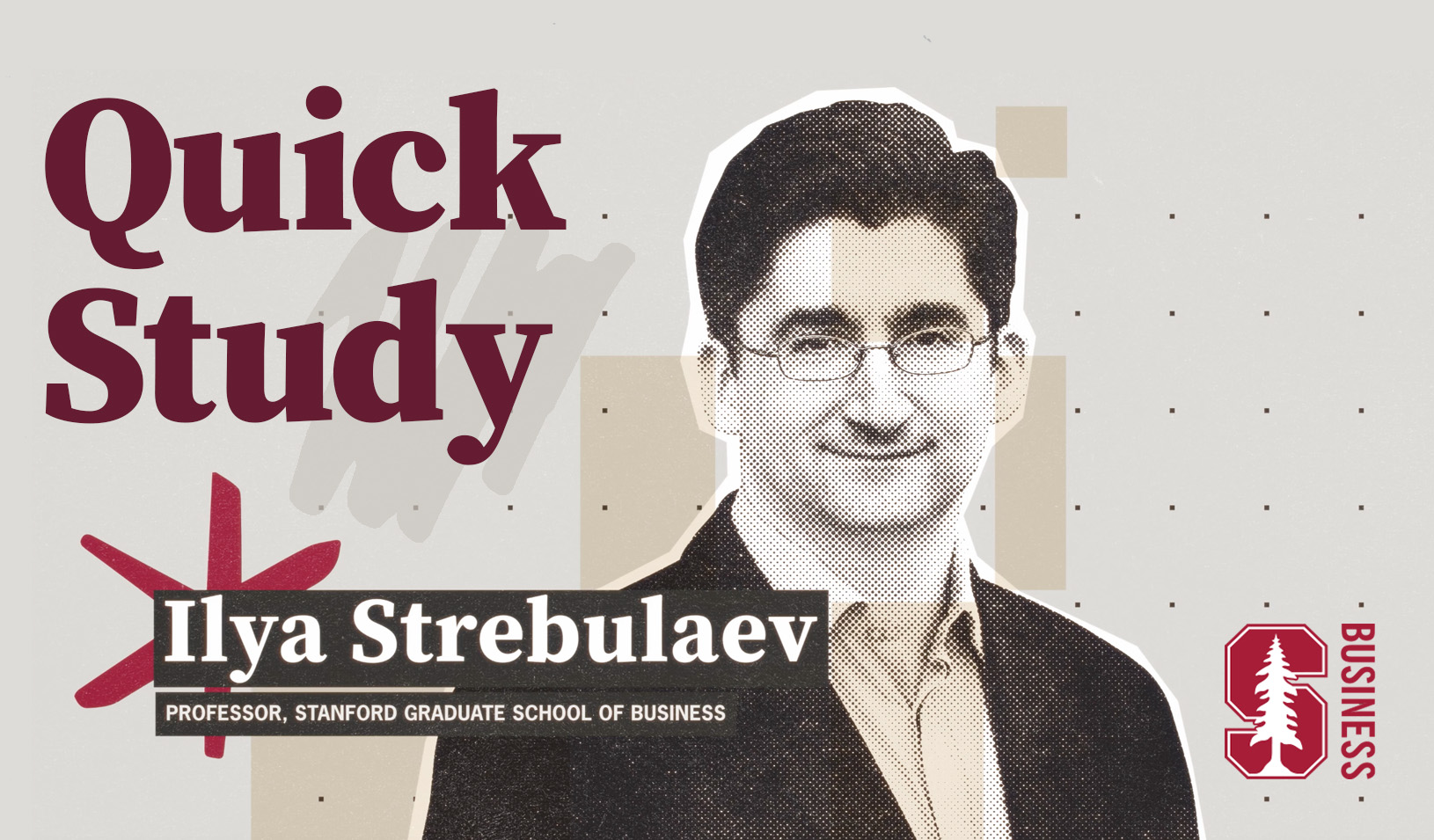No industry needs timely, safe, and accurate transaction records more than the banking industry does, but very few traditional banks have embraced the kind of radical disruption — and possible improved efficiency — promised by blockchain technology.
Most databases of financial records are maintained by centralized institutions, which makes them vulnerable to hacking or natural disasters. It also makes them inefficient. Bank of America, for example, keeps a record of each transaction it completes with other banks, and those other banks also record the same transactions. Keeping those records synchronized requires time, effort, and money.
But because blockchains are decentralized, they provide a way for every party involved in a transaction to access an updated record of the data.
Igor Khmel, who received his MBA from Stanford Graduate School of Business in 2011, believes banks eventually will have to do business using blockchain technology, so in 2016 he founded BankEx, which is developing what it calls a “tokenization ecosystem” that he hopes will usher in a new era for finance and banking. He calls is “Securitization 2.0.”
“I’m not trying to disrupt banks,” Khmel insists. “I’m trying to help and change them.”
The fintech industry has noticed his efforts. Within a year of launching, BankEx was listed on Financial IT’s Pathfinder rankings, spotlighting the 50 most promising new fintech startups. Khmel says the 100-employee BankEx currently has a head office in New York, business development offices in Los Angeles, Hong Kong, and Seoul, and an engineering team in Moscow.
Khmel, a Ukrainian native, studied at Lomonosov Moscow State University and had roles at McKinsey and Deloitte before coming to Stanford. He interned at Citadel hedge fund in Chicago and used his Stanford-centric U.S. experience to land a much-contested position as director general and founder of Sberbank Innovation Labs (part of the state-backed banking firm Sberbank, the largest bank in Russia) and later as managing director at Sberbank Digital Ventures, where he led product development of new technology products. These experiences led Khmel to his current project, BankEx.
What need did you perceive in the banking marketplace that led you to create BankEx?
I saw the need for, basically, the ability to change. Any bank that is older has problems. Regulations on institutions make it difficult for them to take a risk or change. The second problem they have is information technology. Any bank that has IT more than 10 years old is by definition outdated.
But you haven’t exactly been welcomed by the banking industry, right?
I have a strong vision for how the industry should look. I’m talking to different banks in Asia and Canada and Europe and the U.S., and I’m saying, “Guys, it’s happening. This is what’s going on. Let’s do something together. Let us help you to modify yourselves.” Some of them are better about it, and some of them have never thought about this thing yet. But the banks that stay behind will stay like cash machines. And the guys who change will be leaders.
Why are speed and agility so important in the banking world?
Innovation. You have to try many things many times. You have to be willing to make a lot of small mistakes. Otherwise you’ll be late. Otherwise you’ll have to wait until a lot of other guys try something and it becomes the industry standard. By that time you lose the market.
How did you get initial funding to start BankEx?
I started Innovation Labs at Sberbank, where we specialized in acquiring companies and refining them, then integrating them with banks and growing them. I was part of the merger of the biggest bank in the country with the biggest telecom company in the country. So I started BankEx with the same idea, to build companies for banks and to sell to banks. I started it with angel money. I got $100,000 in December 2016, then in March 2017 I raised the same amount for another project, but with a commitment for $1 million. Then they wanted the whole business model to shift to tokenization, so I converted the model to tokenization.
How do these tokens work?
Our flagship technology is called the Proof-of-Asset Protocol, which transforms real assets into highly fungible digital smart assets for any legal jurisdiction in the world. It’s similar to the foundation upon which the gold standard was based. In our case, we are issuing a token on the blockchain, one that represents something of value and that you have complete ownership of.
We read that you raised more than $70 million in token sales.
That was in December 2017. Every month we convert it to some amount of money we need. But at today’s change rate, it’s actually like $10 million.
But where did the money actually come from? Investors?
It came from the crypto community, not investors. It was token buyers.
Is that what you’re using for capital to run BankEx?
We’re growing quickly. But we’re making revenue. We got in 2018 about $4 million paid to the company, and we have another $4 million of deferred revenue. So it’s about $8 million in 2018. We also established a number of joint ventures and are financing those companies. The biggest one is MovieCoin, which is a joint venture between BankEx and Hollywood producers. It’s an entertainment-financing platform built on blockchain technology.
You’ve said your business philosophy — taking the unconventional route with utter rigor and confidence — was born in one of your favorite classes at Stanford: Alphanomics, taught by accounting professor Charles M. C. Lee. What did you learn from him?
In Charles Lee’s class we used practical cases about how to manage money. The information I learned in his class was enough for me to get a job at Citadel hedge fund in Chicago, which was very difficult for me.
Why?
At Stanford, they say you have three ways to change. You can change your position within the same industry, or you can change industries, or you can change the country where you work. They strongly recommend only one change, not two. I basically made two changes when I went to Citadel — I changed industries, and I changed countries. I did it so I’d understand how the industry works. I was able to apply those experiences to my previous background.
You’ve described BankEx as an “operating system for capital markets.” What does that mean?
The idea came from my job in Citadel. Those guys had two layers of coding. They have engineers who code the core language for systems that are used by the traders, and the traders would make some applications on top of this core. Then I saw the same thing in a bank in Germany that does a bank-as-a-service platform, where they basically created a platform in order to integrate with other banks. They were doing something technologically agile that enabled the providers to integrate. Usually integration takes a regular bank 6 to 12 months. But in those cases you can do new things and new integrations in 3 to 4 weeks. Because it’s much quicker, you can try many things this way. The barrier to entry and the cost is much lower. I took that model in order to create the same kind of agile platform for capital markets.
Why is blockchain still viewed as an adversary by many in the traditional banking sector?
There are several reasons for that. First, blockchain is not commercially reliable. So anything built on blockchain cannot meet banks’ service-level agreements, known as SLAs. The second reason is that blockchain is associated with cryptocurrencies. There’s a lot of money there that didn’t go through the proper procedures, and that’s why it’s regarded as unclean money. Banks don’t want to be associated with that. The regulations are not there yet, so the banks stay away. But that’s changing. Banks are finally starting to recognize the difference between cryptocurrencies and blockchain.
Walmart recently announced plans to have all of its produce growers use blockchain technology in order to be able to better track the supply chain. What does that suggest to you about the future?
I think a lot about this case. It’s definitely a case of where a big adoption of blockchain can happen. In Walmart’s case, they’re using it for supply-chain stability, and food trust is exactly one of the natural ways to use blockchain. But banks are another.
For media inquiries, visit the Newsroom.






